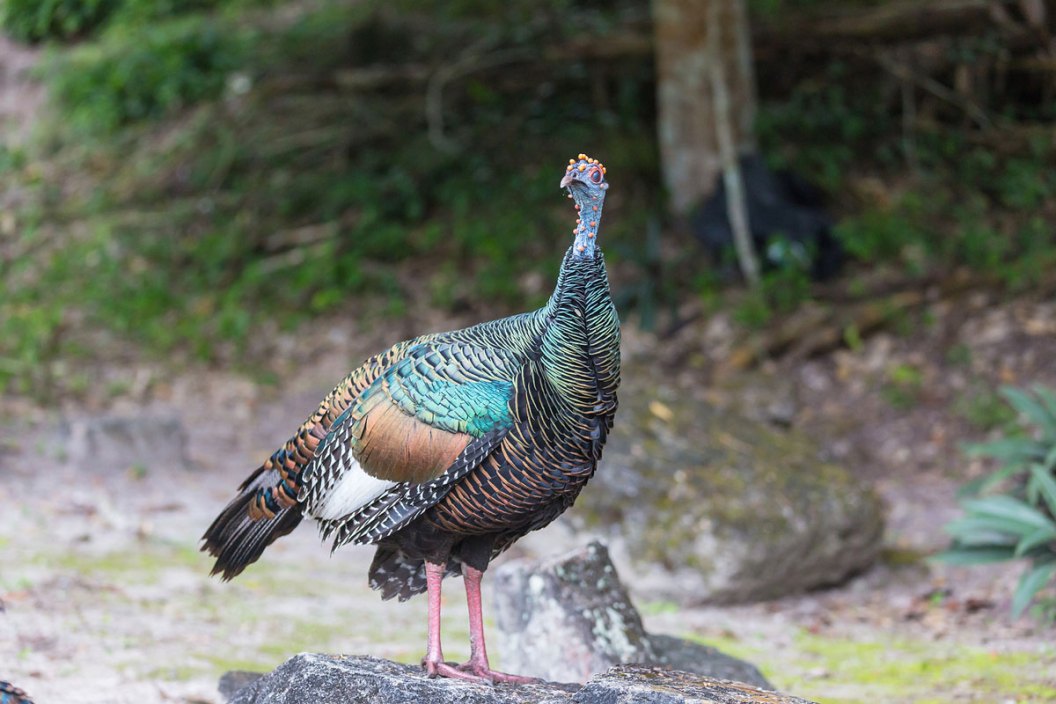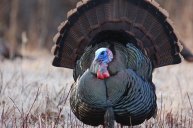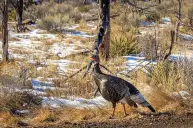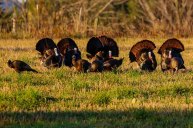Showy and rare, the Ocellated turkey is a bird that has the respect of ancient Mayans, avian biologists, and hunters alike.
The diminutive, beardless bird we know as the ocellated turkey (Meleagris ocellata), is one of six recognized turkey varieties worldwide.
Whereas the other five varieties are subspecies of the common turkey, Meleagris gallopavo, the ocellated is an altogether separate species of turkey.
While you won't be hunting these guys in the states anytime soon, they are a very cool, unique bird that you should take time to get to know.
General Description
Looking something akin to a peacock that was bred with a wild turkey, the Ocellated turkey (Meleagris ocellata) has stunning plumage that sports a black, brown, green, blue and bronze iridescence.
These striking body colors are accentuated by bluish-gray tail feathers with bright gold tips and feature blue-bronze eye spots (ocelli) near the end of the feathers.
The ocellated turkey gets its namesake from the ocelli, located at the end of the tail feathers. Oculus is the Latin word for eye.
The wing feathers have bars similar to its North American wild turkey cousins.
The ocellated turkey lacks the beard and wattle that other turkeys have but does have a snood, which is the little protuberance that dangles to the side of the beak.
Both males and females have a bright blue head with scattered yellow-orange "warts" or nodules. These warts, called caruncles, are more pronounced on the male turkeys. Think of them as face jewelry!
During the mating season, the caruncles become more visible and help the toms woo the ladies.
Spurs tend to be much longer and thinner than our turkeys here in North America.
Ocellated Turkey Range
The range for the "near threatened" ocellated turkey is small. With an estimated population of 20,000-50,000 birds, it only exists on the Yucatán Peninsula. This includes the farthest southeastern reaches of Mexico, the northern half of Belize, and the upper third of Guatemala—about the size of Alabama in total.
Vocalizations
Ocellated turkeys, like many bird species, have a diverse range of vocalizations depending on age and gender. The males don't really "gobble," as much as they sound like you were trucking to your set-up, tripped, and sent your box call flying onto the ground.
The ocellated turkey does not have your typical thunder chicken gobble. It is described by National Wild Turkey Federation (NWTF) as "high-pitched gobbles that are preceded by a hollow drumming sound." The hens cluck and whistle, sounding something close to common wild turkeys.
You can check out some of their vocalizations here at The Cornell Lab of Ornithology's Macaulay Library.
Behavior
Like the other varieties of turkey, the ocellated turkey feeds during the day and roosts in trees at night.
During the breeding season (February through April) gobblers from Guatemala to Tabasco, Quintana Roo, and Yucatán strut their stuff for the ladies in impressive courtship displays. Who says guys can't dance!?
In the early morning hours before sunrise, males spread their tail fan, pull their heads back over their body, drag both wings on the ground and vibrate one wing. An adult male will circle a hen while strutting. If she is receptive, she will squat down for copulation. Otherwise, she bails. Just another night at the bar.
The birds head back into the cooler temps of the forest after sunrise, where the toms continue singing from the forest floor.
Hens begin laying eggs between mid-March and mid-May with typically 8-16 per clutch.
They are omnivores, feeding on a familiar diet of insects, seeds, grains, nuts, leaves and berries.
Hunting Ocellated Turkey
If you are looking for a truly exotic turkey hunt, you can head to the dense humid jungles of Central America and hunt them on the Yucatán Peninsula.
Hunts also take place in agricultural areas, on soybean, corn and sorghum farms.
Just like our American birds, spring and fall hunts are available. But mid-March through April is the suggested time to go.
Unfortunately, public hunting land south of the border is basically non-existent. Unless you have connections and land to hunt you will have to go with an outfitter.
For your own safety and staying legal with regards to firearms and bringing meat/trophies back across the border, you probably want to do this anyway.
Ocellated turkeys were historically hunted by shooting them off the roost. Depending on the outfitter and/or area you hunt, they are still hunted this way. Yes, we consider this poor sportsmanship in the states.
However, in the thick jungles of the Yucatán with tons of predators, you will be hunting wary birds that don't vocalize a lot. Sometimes "off the roost" is the only viable way of getting it done. Also, remember, you are not in the U.S.
As the saying goes, "When in Rome . . ."
According to NWTF, hunting methods are shifting and hunters are now making use of decoy and calling tactics, especially in farming areas.
Some outfitters that hunt farming areas in the Mexican state of Campeche, use ground blinds exclusively.
The typical cost for hunting ocellated turkey ranges from $2,500-$4,000, minus items like gratuities, additional hotel nights for arriving and departing from airport, airfare and trophy shipping costs.
It is a hefty price tag, but if you're looking for a unique hunt or the crown jewel to complete your World Slam, the ocellated turkey is it.
NEXT: HOW TO MAKE VENISON HASH BROWN CHILI
WATCH





